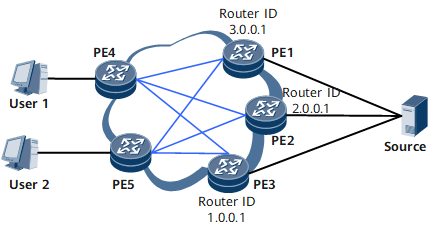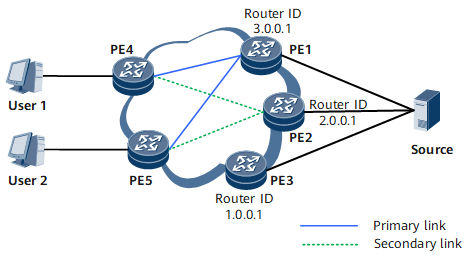UMH Route Selection Fundamentals
Background
On an NG MVPN, when multiple sender PEs exist, receiver PEs select routes based on preferred unicast routes by default. In this case, different receiver PEs select different sender PEs as their root nodes. This requires multiple P2MP tunnels to be established. As a result, many public network tunnel resources are consumed. To resolve the preceding issue, enable the highest IP address to be selected as the upstream multicast hop (UMH) on receiver PEs, so that the receiver PEs select the same sender PE as their root node during VPN route selection.
Implementation
UMH route selection fundamentals
Figure 1 shows the fundamentals of UMH route selection on an NG MVPN.
PE1, PE2, and PE3 are sender PEs and advertise VPN routes of the VPN multicast source or RP. Both PE4 and PE5 can receive routes from the VPN multicast source or RP. The unicast routes, from PE4 to the VPN multicast source or RP, advertised by PE3, PE2, and PE1 are in descending order of priority. The unicast routes, from PE5 to the VPN multicast source or RP, advertised by PE2, PE3, and PE1 are in descending order of priority.
After the system is enabled to select the highest IP address as the UMH in a VPN instance on PE4 or PE5:
PE4 or PE5 constructs a UMH route candidate set and imports the VPN-IP routes with the same prefix of the same VPN. Each UMH route candidate record consists of route, UpstreamPE, and UpstreamRD. PE4 or PE5 then selects the highest IP address from the upstream PEs' IP addresses as the UMH.
According to the preceding topology, PE4 and PE5 select the route advertised by PE1 as the UMH route because PE1's IP address is the highest. Both PE4 and PE5 use the route to construct a C-multicast route. The RD in the C-multicast is the UpstreamRD of the selected route, and the vpn-target in the C-multicast route is the VRF Route Import Extend Community of the selected route.

When the VPN-IP route does not contain the VRF Route Import Extended Community, upstream PEs obtain it from the BGP next-hop address of the VPN-IP route. In this case, a C-multicast route cannot be constructed and VPN multicast routes cannot be established.
After the function of enabling the highest IP address to be selected as the UMH on a PE, VPN multicast load splitting does not take effect on the (*, G) and (S, G) entries across the public network, but takes effect on the (*, G) and (S, G) entries that are not across the public network.
Dual-root 1+1 protection
NG MVPN dual-root 1+1 protection is implemented as follows:
In the UMH route candidate set, PE4 or PE5 selects the largest route from the upstream PEs' routes as the primary route, and selects the second largest route from the upstream PEs' routes as the backup route.
On the network shown in Figure 2, after the system is enabled to select the highest IP address as the UMH on PE4 and PE5, both PE4 and PE5 select PE1 as the primary root node and PE2 as the secondary root node. If PE1 fails, both PE4 and PE5 select PE2 as the primary root node and PE3 as the secondary root node based on the dual-root 1+1 protection mechanism.

